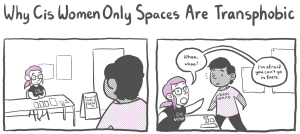
Source: Getty Images
Originally published on Binge Behavior and cross-posted here with their permission.
Hopeless. Desperate. Defeated. Disgusted. Guilty. Ashamed.
None of these adjectives describe feelings that any of us like to experience.
Yet people with binge eating disorder (BED) may experience them every day.
Eating controls their life, but there’s really no control there. Indeed, BED is characterized by a feeling of being out of control.
What is BED?
Binge eating disorder involves frequent episodes of out-of-control eating, followed by feelings like those listed above.
While it’s often thought that a binge means a very large amount of food, for some, the amount may be relatively small.
It’s the feelings around the eating that typify the disorder, and that’s also what distinguishes it from simple overeating.
Although 2013 marks the official recognition of BED as an eating disorder within the Diagnostic and Statistical Manual (used to aid clinicians in diagnosing mental health disorders), BED is actually the most common eating disorder.
Estimates are that:
- Over 52 million women in the US – 3.5% – suffer with the problem.
- Approximately 2% of men do – about 30 million.
- Children and adolescents also suffer with BED.
- It’s very commonly seen among people who struggle with weight. Approximately 30 to 40% of people who enter weight loss treatment programs have BED.
At its core, BED is emotional eating gone awry.
Emotional eating can be part of normal, healthy eating. We all eat occasionally when we’re not hungry – to celebrate, or when we’re bored, or even just because something looks like it tastes good.
But when eating is the primary way that we manage our emotions, it becomes problematic.
With BED, a person regularly uses food to escape, to reward themselves, to avoid stressful situations, to soothe anxiety, fear, shame, grief, or loneliness, or to express anger, frustration, and the like.
After eating, the person with BED often then layers on additional emotions as they feel dismay over their eating, which can spur additional eating.
It becomes an unending cycle of despair.
How Does Someone Develop BED?
It’s easy to see where the difficult emotions that arise from overeating come from.
In today’s society, most people believe healthy eating is defined by diet rules – we should eat this, we shouldn’t eat that, we should only eat in these situations, we shouldn’t eat in those situations.
When we don’t follow the rules, we believe we’re doing something wrong. Add in weight struggles, and you’ve got a recipe for binge eating out of guilt and defeat.
Successfully following diet rules can set us up for binge eating, too.
One of the most common triggers for binge eating is getting too hungry. Overeating is a normal response to getting too hungry; feeling guilty about the overeating is what turns it into a binge.
While dieting is a trigger for BED for many people, others can diet without developing BED.
Why are they different?
For one, there are definite genetic contributors to the development of BED, meaning you often see several people within a family struggling with the disorder.
Other causes can include co-existing mood disorders, like bi-polar disorder, and significant trauma or loss experiences.
One of the most common contributors these days is thought to be weight stigma, or discrimination or bullying based on a person’s size.
Weight stigma often leads to a person trying to change their natural, healthy body size through dieting, which sets in motion a struggle against fundamental physiological mechanisms that are there to help ensure survival.
That a person cannot win against basic survival mechanisms is almost guaranteed; the failure that ensues can set up feelings that drive emotional overeating.
Weight stigma can also mean lower self-esteem. Food is commonly used to soothe the emotions that come from feeling inadequate or unwanted.
Although the majority of people with BED live in larger bodies, those who are smaller may also be triggered to develop BED because of weight stigma. Essentially, the fear of weight gain is at the core of that development.
Some people do develop BED without any history of dieting or weight stigma.
Generally for these folks, early trauma led to using food to soothe “enormous core shame, little sense of Self, and fear/lack of sense of safety in the world,” says Amy Pershing, LMSW, ACSW, chair of the Binge Eating Disorder Association (BEDA).
Concern about weight, however, often plays a role in sustaining the disorder in this case.
How Do You Treat BED?
Professional help from specialists skilled in treating eating disorders is advised for anyone struggling with BED.
An effective treatment team generally includes a psychiatrist, psychologist, and registered dietitian.
Key elements in effective treatment include:
1. Compassion, Caring, and Support
From those treating BED as well as those who are being treated.
The last part is very important. people who struggle with BED and other eating disorders can significantly benefit by becoming more compassionate towards themselves and their struggle, opening the door to understanding what is going on underneath the eating.
2. Psychotherapy
Whether it be individual or group-based therapy, exploring the underlying issues that are part of a person’s struggle with BED is key to understanding how to treat it effectively.
Research supports the effectiveness of cognitive behavioral therapy, mindfulness-based interventions, Internal Family Systems therapy, and psychodynamic psychotherapy in the treatment of BED.
Other modalities are available and may be effective but have not been researched yet.
3. Predictable Eating
This means eating regularly and eating well-balanced meals and snacks.
People with BED may not be able to tell when they are hungry, so starting to eat every 3-5 hours or so can be a good strategy to help prevent overeating that comes from getting too hungry.
A balance of protein foods, starchy foods, vegetables and/or fruit at meals helps provide the nutrients that support appetite regulation.
4. Non-Judgment About Food
Giving up notions of “good” and “bad” foods helps a person decide how much they really want of different foods.
When we believe we shouldn’t or can’t have something, yet we really like it, we set up a push-pull dynamic that often leads to overeating.
5. Self-Monitoring Tools
Often, these are a form of food journaling. But they are not the diet diaries of old that were used to control eating.
Instead, they are used to gain awareness of patterns of thinking, feeling, and acting.
A food journal that includes a hunger scale can help a binge eater get back in touch with how they feel when they are hungry and when they are satisfied.
An eating/emotions journal in which a person records how they feel emotionally before, during and after eating can help raise awareness of the emotions that drive eating.
6. Physical Activity
People who binge eat often say they live from the neck up. They’re disconnected from their bodies.
Physical activity helps reconnect the head to the body, to aid people in better recognizing what their body needs to feel well.
Physical activity is also a great stress reducer.
It’s counter-productive to think of physical activity as a way to burn calories; that makes it something that is done more as a punishment than as a way to feel better.
Where Does Weight Loss Fit into the Treatment of BED?
It really doesn’t fit at all.
Many larger-bodied people with BED have a long history of dieting that has left them feeling deprived and bad about their bodies.
Effective treatment includes stepping away from the judgment about body size. That generally doesn’t happen when someone is actively focused on losing weight.
Additionally, a focus on weight loss can pull someone back into restrictive eating, which exacerbates the eating disorder.
Even when a person has successfully dealt with BED, a focus on weight loss is often not advisable.
An emphasis on healthy behaviors that lead to healthy weights as a “side effect” is generally a better approach for anyone who has struggled with an eating disorder.
That goes hand-in-hand with a focus on developing a healthy relationship with food and the body, to give a person their best chance at achieving and maintaining a healthy weight.
That said, many people with BED may be significantly malnourished due to the nutritional quality of the food they regularly eat.
They may benefit from work with a nutritionist to help heal their bodies as well as their minds.
It is important to work with a nutritionist who is skilled in treating disordered eating so as not to trigger disordered eating attitudes or behaviors.
Common Myths Associated with Binge Eating Disorder
How many of these myths have you heard before?
1. Everyone who has BED is overweight.
Although those with BED are more likely to be at a higher weight, many people who struggle with the disorder aren’t. It’s estimated that 1 out of every 3 people with BED are not at a higher weight.
2. Most fat people have BED.
To the contrary, many people who live in larger bodies are happy and healthy. You cannot tell anything about a person’s health or behaviors based solely on what they look like.
3. BED is really just gluttony.
Equating binge eating disorder with gluttony is like saying dyslexia is a matter of intelligence. BED is a disorder with genetic, psychological, emotional, and social roots.
4. Anyone can stop binge eating if they just use a little willpower.
In the absence of understanding what drives the binge eating, attempting to just stop it may actually make matters worse. That takes away the purpose that bingeing serves in a person’s life without providing any substitute strategies.
How To Get Help with Binge Eating
If you frequently feel upset about your eating, whether it’s bingeing or not, it’s always a good signal that professional help might be needed.
Look for a professional who is experienced in treating BED, and ask questions about their approach based on information in this article.
According to BEDA, the process of recovery is an ongoing life-long process of growth and insight. But change is possible.
BEDA lists a variety of resources for treating binge eating disorder on their website. The organization is also in the process of developing a provider directory.
Want to discuss this further? Login to our online forum and start a post! If you’re not already registered as a forum user, please register first here.
Marsha Hudnall, MS, RD, CD, is president and co-owner of Green Mountain at Fox Run, a women’s retreat in Vermont that pioneered the non-diet approach to health and healthy weights in 1973. Marsha is passionate about helping people find the joy in eating well, the pleasure in moving their bodies regularly, and the peace of living a life free of constant worry about eating and weight. She sits on the boards of the Binge Eating Disorder Association and The Center for Mindful Eating. You can read more from her at Green Mountain’s blog A Weight Lifted and reach her on Twitter @MarshaHudnall.
Search our 3000+ articles!
Read our articles about:
Our online racial justice training
Used by hundreds of universities, non-profits, and businesses.
Click to learn more




















